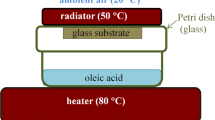Abstract
Soda-lime-silica glasses were treated by an argon plasma, that was generated by an inductively-coupled rf power supply. The surface composition of the treated glasses were profiled using SIMS, and the glass structure was probed using diffuse reflectance FTIR spectroscopy. A Buehler Micromet II (micro hardness tester) was used to measure hardness. The effects of various process parameters such as temperature, gas pressure and treatment time on glass surface composition, structure and properties are discussed. The results show that the surfaces of the treated samples were dealkalized to some depths as great as 0.5 µ. The surface structure of the treated glasses is close to that of pure silica glass and surface hardness is improved after plasma treatment.
Similar content being viewed by others
References
J. Szekely, “A Overview of Plasma Processing,” Mater. Res. Soc. Symp. Proc., 30 1–11 (1984).
T. S. Eriksson, S. J. Jiang and C. G. Granqvist, Solar Energy Materials, 12 319–25 (1985).
F. B. Vurzel, “Some Special Applications of Low-Temperature Plasma”, pp.175–88 in Proceedings of the First Annual International Conference of Plasma Chemistry and Technology; Edited by H.V. Boeing. Technomic Publishing Co., Inc., Moscow, 1983.
T. K. Vethanayagam and P. F. Johnson, Mater. Res. Soc. Symp. Proc., [75] 293–301, 1987.
F. G. K. Bauke, Private Communication, October, 1988.
J. L. Lineweaver, Journal of Applied Physics, 34 [6] 1786–1791 (1963).
A. K. Varshneya, A. R. Cooper, and M. Cable, Journal of Applied Physics, 37 [5] 2199 (April 1966).
F. Ohuchi, M. Ogino and P. H. Holloany, Surface and interface analysis, 2 [3] 85–90 (1980).
R. K. Brow, Journal of Non-Crystalline Solids, 107 1–10 (1988).
H. Bach, Radiation Effects, 28 215–216 (1976).
D. V. McCaughan, R. A. Kushner and V.T. Murphy, Physical Review Letters, 30 [13] 614–617 (1973).
B. M. J. Smets and T. P. A. Lommen, Journal of The American Ceramic Society, 65 C–80 (1982).
Xiaobo Zhou, M. S. Thesis, Alfred University, NY (1990).
Xiaobo Zhou, Xiaoming Li, Paul. F. Johnson, Proc. 10th Univ. Conf. on Glass Science: Phys. Chem. Glass Surface, Univ. Park, PA. June 7-9, 1989.
D. E. Clark, E. C. Ethridge, M.F. Dilmore and L.L. Hench, Glass Tech., 18 [4] 121–124 (1977).
D. M. Sanders, W. B. Person and L. L. Hench, Appl. Spectrosc., 2 [5] 530–536 (1972).
D. M. Sanders, W. b. Person and L. L. Hench, Appl. Spectrosc.28 [3] 247–255 (1974).
Author information
Authors and Affiliations
Rights and permissions
About this article
Cite this article
Zhou, X., Condrate, R.A. & Johnson, P.F. Plasma Enhanced Glass Surface Modification: Structure and Properties. MRS Online Proceedings Library 190, 119–124 (1990). https://doi.org/10.1557/PROC-190-119
Published:
Issue Date:
DOI: https://doi.org/10.1557/PROC-190-119



